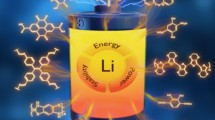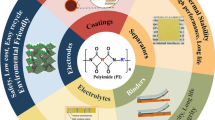Abstract
Li2FeSiO4 (LFS) nanorods, with a diameter of 80–100 nm and length of 0.8–1.0 μm, were synthesized successfully from a mixture of LiOH, FeSO4, and SiO2 nanoparticles via a simple hydrothermal process. The secondary structure with micro-sized bundles of nanorods was developed with high crystallinity under the hydrothermal condition of 180 °C for 72 h. Then, sucrose, as carbon source, was coated and carbonized on the surface of the LFS nanorods to fabricate LFS/C nanorod composite. The resulting LFS/C nanorod composite was characterized by X-ray diffraction, scanning electron microscopy, transmission electron microscopy, thermogravimetric analysis, and surface area measurements. When used as the cathode materials for lithium-ion battery, the electrochemical performance of the LFS/C nanorod material delivers discharge capacities of 156 mAh g−1 in the voltage window of 1.8−4.7 V and also demonstrates good cycle stability when it is cycled between 1.8 and 4.1 V. In short, superior electrochemical properties could be caused by the short lithium-ion diffusion path of its nanorod structure.









Similar content being viewed by others
References
Armstrong AR, Kuganathan N, Islam MS, Bruce PG (2011) Structure and lithium transport pathways in Li2FeSiO4 cathodes for lithium batteries. J Am Chem Soc 133:13031–13035
Bui KM, Dinh VA, Ohno T (2012) Diffusion mechanism of polaron–Li vacancy complex in cathode material Li2FeSiO4. Appl Phys Express 5:125802
Chen W, Lan M, Zhu D, Wang C, Xue S, Yang C, Li Z, Zhang J, Mi L (2013) Synthesis, characterization and electrochemical performance of Li2FeSiO4/C for lithium-ion batteries. RSC Adv 3:408–412
Dompablo ME, Arroyo-de, Armand M, Tarascon JM, Amador U (2006) On-demand design of polyoxianionic cathode materials based on electronegativity correlations: an exploration of the Li2MSiO4 system (M = Fe, Mn Co, Ni). Electrochem Commun 8:1292–1298
Ferg E, Gummow RJ, de Kock A, Thackeray MM (1994) Spinel anodes for lithium-ion batteries. J Electrochem Soc 141:L147–L150
Gong ZL, Li YX, He GN, Li J, Yang Y (2008) Nanostructured Li2FeSiO4 electrode material synthesized through hydrothermal-assisted sol-gel process. Electrochem Solid State Lett 11:A60–A63
Hsu CH, Liao HY, Kuo PL (2014) High speed transfer lithium ion inside mesoporous core–shell LiFePO4/carbon sphere cathodes. Energy Technol 2:409–413
Kuo PL, Hsu CH, Chiang HT, Hsu JM (2013) High rate performance intensified by nano-sized LiFePO4 combined with three-dimensional graphene networks. J Nanopart Res 15(UNSP):1966
Liivat A, Thomas JO (2011) Li-ion migration in Li2FeSiO4-related cathode materials: a DFT study. Solid State Ion 192:58–64
Moskon J, Dominko R, Cerc-Korosec R, Gaberscek M, Jamnik J (2007) Morphology and electrical properties of conductive carbon coatings for cathode materials. J Power Sources 174:683–688
Nishimura SI, Hayase S, Kanno R, Yashima M, Nakayama N, Yamada A (2008) Structure of Li2FeSiO4. J Am Chem Soc 130:13212–13213
Nytén A, Abouimrane A, Armand M, Gustafsson T, Thomas JO (2005) Electrochemical performance of Li2FeSiO4 as a new Li-battery cathode material. Electrochem Commun 7:156–160
Nytén A, Kamali S, Haggstrom L, Gustafsson T, Thomas JO (2006) The lithium extraction/insertion mechanism in Li2FeSiO4. J Mater Chem 16:2266–2272
Saracibar A, Van der Ven A, Dompablo ME, Arroyo-de (2012) Crystal structure, energetics, and electrochemistry of Li2FeSiO4 polymorphs from first principles calculations. Chem Mater 24:495–503
Sirisopanaporn C, Masquelier C, Bruce PG, Armstrong AR, Dominko R (2010) Dependence of Li2FeSiO4 electrochemistry on structure. J Am Chem Soc 133:1263–1265
Tarascon JM, Armand M (2001) Issues and challenges facing rechargeable lithium batteries. Nature 414:359–367
Xu K (2004) Nonaqueous liquid electrolytes for lithium-based rechargeable batteries. Chem Rev 104:4303–4418
Yabuuchi N, Yamakawa Y, Yoshii K, Komaba S (2010) Hydrothermal synthesis and characterization of Li2FeSiO4 as positive electrode materials for Li-ion batteries. Electrochemistry 78:363–366
Yabuuchi N, Yamakawa Y, Yoshii K, Komaba S (2011) Low-temperature phase of Li2FeSiO4: crystal structure and a preliminary study of electrochemical behavior. Dalton Trans 40:1846–1848
Yan ZP, Cai S, Zhou X, Zhao YM, Miao LJ (2012) Sol-gel synthesis of nanostructured Li2FeSiO4/C as cathode material for lithium ion battery. J Electrochem Soc 159:A894–A898
Zaghib K, Mauger A, Groult H, Goodenough J, Julien C (2013) Advanced electrodes for high power Li-ion batteries. Materials 6:1028–1049
Zanello P (2003) Voltammetric techniques. In: Inorganic electrochemistry: theory, practice and application. Royal Society of Chemistry, UK
Zhang S, Deng C, Yang SY (2009) Preparation of nano-Li2FeSiO4 as cathode material for lithium-ion batteries. Electrochem Solid State Lett 12:A136–A139
Acknowledgments
The authors would like to thank the Ministry of Science and Technology, Taipei, R. O. C. for their generous financial support of this research.
Author information
Authors and Affiliations
Corresponding author
Electronic supplementary material
Below is the link to the electronic supplementary material.
Rights and permissions
About this article
Cite this article
Hsu, CH., Shen, YW., Chien, LH. et al. Li2FeSiO4 nanorod as high stability electrode for lithium-ion batteries. J Nanopart Res 17, 54 (2015). https://doi.org/10.1007/s11051-014-2810-7
Received:
Accepted:
Published:
DOI: https://doi.org/10.1007/s11051-014-2810-7




